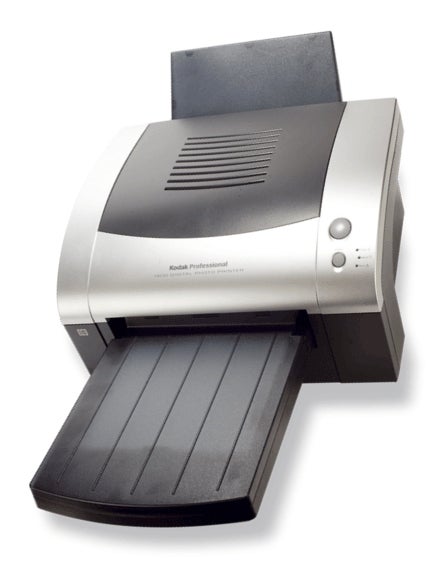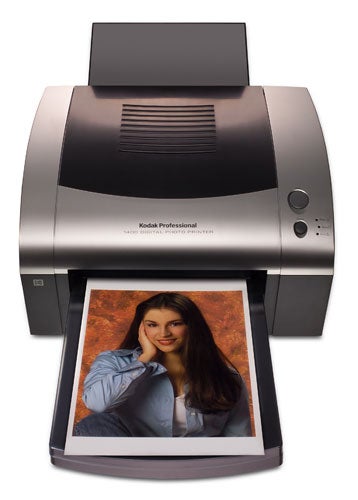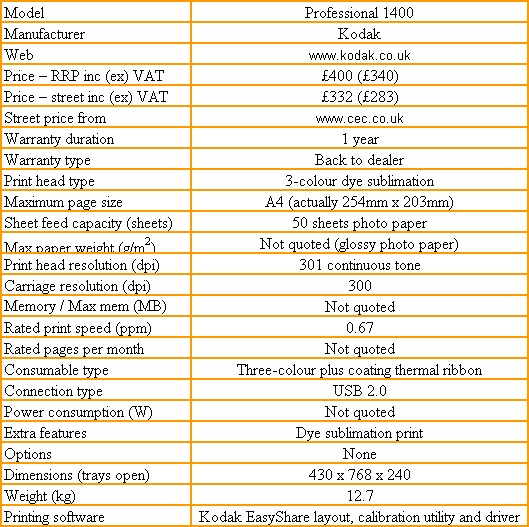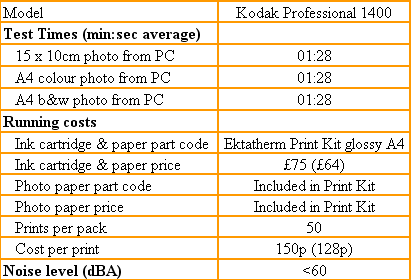Kodak Professional 1400 – Dye Sublimation Printer Review
Kodak Professional 1400 – Dye Sublimation Printer
Dye sublimation printers have always been popular with professional photographers. Will they go for Kodak's new 1400?

Verdict
Key Specifications
- Review Price: £283.00
Printers designed for the semi-pro or professional photography market use a number of different printing techniques and dye sublimation is a popular one. Kodak’s new Professional 1400 is considerably cheaper than its previous Professional 8500 model and can handle pages up to full A4. Well, nearly full A4, as you’ll learn.
When you unbox the basic printer it looks quite bulky but it’s not that much bigger than a similar semi-pro inkjet machine. However, by the time you’ve clipped in a feed tray to the front and an intermediary cover at the back, it does takes up a lot of desk space. These full covers are important, as otherwise you’re likely to have problems with dust particles.
There are just two buttons on the top surface of the Professional 1400, one to open the cover and the other to cancel a print job. Three indicators show power, media status and error conditions.
Installation of the ribbon cartridge is a bit fiddly, as you have to load both feed and take up rollers with the ultra-thin dye-sub ribbon between them into a flimsy plastic carrier, before lowering it into the printer. The print head, which heats the dyes through the film substrate on which they’re coated, is attached to the lid of the machine and comes down in contact with the ribbon as you close it.
There are three different utilities provided with the printer: a driver, a calibration utility and the EasyShare software, which enables you to print several images, arranged on a single sheet of paper. All install easily and although calibration is a five-step process, several of these steps seem to be ensuring that the software knows which printer it’s dealing with. It then prints a matrix of grey swatches and asks you to pick the most neutral. Once you’ve done this, the details are downloaded to the printer and calibration is complete.
When you print, a sheet of Ektatherm photo paper is taken from the front feed tray to the back of the machine and yellow dye is transferred from the dye-sub ribbon in the first pass until the paper protrudes partly from the front. It’s then drawn back in again for the magenta and then cyan dyes and finally for the transparent Xtralife coating, which protects the print from water and light scratches. Pages eject at the end of printing onto the top cover of the paper feed tray.
Despite the paper having to pass through the Professional 1400 four times during printing, results are quick and consistent. Each page we printed took just under the 90 seconds Kodak claims for a full-page print. It’s much faster than typical inkjets can manage, but doesn’t look quite as impressive if you’re printing less than a full page. No matter what area you’re printing, the print times stays at a steady 1 minute, 28 seconds.
The quality of print from the dye sublimation process, where a solid ink sublimes to its vapour form, is very good. No matter how closely you look at the prints, there are no visible dots, which is why the process is known as continuous tone. It is sensitive to any dust falling on the paper, though, and this shows as, usually white, spots on your finished prints. Best not to move the printer around to much and to keep the covers on all the time.
Colour rendition is pretty good, though we did notice a slight yellow cast when compared directly with our digital originals, even after printer calibration. Greyscale prints are close to neutral, though with a very slight pink tinge.
One unexpected restriction with our review printer was that we couldn’t get a full A4 print. The printer started printing around 25mm from the top of the page and left a border of around 15mm at the bottom. The maximum image length we could achieve was 254mm, some way short of the A4 page length of 297mm. The Professional 1400 certainly can’t do A4 full-bleed.
(image:1400-1)
Kodak claims a sound level of less than 60dBA from the printer and that’s what we found. In other words, it’s noisy when printing and most of that noise is intrusively high-pitched.
It’s particularly easy to work out how much each page from this printer costs to print, as Kodak sells a 50 page pack which includes both paper and a ribbon cartridge for exactly that number of prints. The cheapest we could find the pack for was £75, giving a cost per page of £1.50p. That’s for a full A4 page, but with the supplied EasyShare software – or with judicious layout skills in other applications – you can get three 15 x 10cm prints onto one sheet. That still brings them out at 50p each of course, which is pricey compared with typical ink-jets. You’ll also have to arrange to print all your images in groups of three if you want to keep wastage down and you’ll also have to cut out and trim smaller prints.
”’Verdict”’
This is a no-fuss printer for the semi-pro or professional photographer who wants to print or proof 10 x 8-inch or A4 images in a repeatable and predictable way. Output quality is very good, especially with the water and fingerprint resistant Xtralife coating. However dust specks can be a problem and may restrict the Professional 1400’s use as an ‘event’ printer.


Trusted Score
Score in detail
-
Print Speed 9
-
Features 7
-
Value 7
-
Print Quality 9

